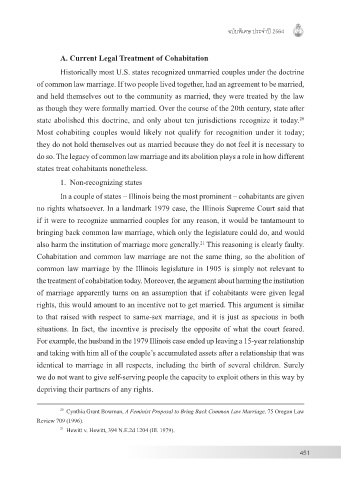Page 453 - วารสารกฎหมาย ศาลอุทธรณ์คดีชํานัญพิเศษ
P. 453
ฉบับพิเศษ ประจำ�ปี 2564
A. Current Legal Treatment of Cohabitation
Historically most U.S. states recognized unmarried couples under the doctrine
of common law marriage. If two people lived together, had an agreement to be married,
and held themselves out to the community as married, they were treated by the law
as though they were formally married. Over the course of the 20th century, state after
state abolished this doctrine, and only about ten jurisdictions recognize it today.
20
Most cohabiting couples would likely not qualify for recognition under it today;
they do not hold themselves out as married because they do not feel it is necessary to
do so. The legacy of common law marriage and its abolition plays a role in how different
states treat cohabitants nonetheless.
1. Non-recognizing states
In a couple of states – Illinois being the most prominent – cohabitants are given
no rights whatsoever. In a landmark 1979 case, the Illinois Supreme Court said that
if it were to recognize unmarried couples for any reason, it would be tantamount to
bringing back common law marriage, which only the legislature could do, and would
also harm the institution of marriage more generally. This reasoning is clearly faulty.
21
Cohabitation and common law marriage are not the same thing, so the abolition of
common law marriage by the Illinois legislature in 1905 is simply not relevant to
the treatment of cohabitation today. Moreover, the argument about harming the institution
of marriage apparently turns on an assumption that if cohabitants were given legal
rights, this would amount to an incentive not to get married. This argument is similar
to that raised with respect to same-sex marriage, and it is just as specious in both
situations. In fact, the incentive is precisely the opposite of what the court feared.
For example, the husband in the 1979 Illinois case ended up leaving a 15-year relationship
and taking with him all of the couple’s accumulated assets after a relationship that was
identical to marriage in all respects, including the birth of several children. Surely
we do not want to give self-serving people the capacity to exploit others in this way by
depriving their partners of any rights.
20 Cynthia Grant Bowman, A Feminist Proposal to Bring Back Common Law Marriage, 75 Oregon Law
Review 709 (1996).
21 Hewitt v. Hewitt, 394 N.E.2d 1204 (Ill. 1979).
451

